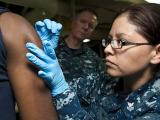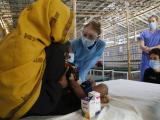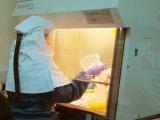Dec 6, 2002 (CIDRAP News) – The Centers for Disease Control and Prevention (CDC) has revised and expanded its guidelines for ensuring that laboratories keep dangerous pathogens from falling into the hands of terrorists.
The guidelines were expanded in response to the Public Health Security and Bioterrorism Preparedness and Response Act of 2002, passed last June. That law included several new restrictions on handling of dangerous pathogens used in research, or "select agents." The law says that select agents can be handled only by people who have a legitimate need to do so and that all facilities that possess such agents must register with the Department of Health and Human Services (HHS). Previously, labs had to register with HHS if they sent out or received shipments of select agents, but didn't have to register for possession of the agents.
The revised guidelines, titled "Laboratory Security and Emergency Response Guidance for Laboratories Working with Select Agents," were published today in Morbidity and Mortality Weekly Report. Their publication came 2 weeks after Congress's General Accounting Office (GAO) issued a report citing some weaknesses in the CDC's Select Agent Program, a program for confining such agents to properly registered labs.
The GAO report called for improvements in several areas, including the inspection of facilities that register to transfer select agents, monitoring of select agent shipments, and the accuracy of CDC records of registered labs and select agent transfers. The report said HHS agreed with the recommendations and had already begun making some of the improvements.
The new guidelines amend an HHS report called Biosafety in Microbiological and Biomedical Laboratories, last revised in 1999. All the guidelines are presented as recommendations, not legal requirements. A footnote to the guidelines says the new regulations on select agents will be spelled out in Title 42 of the Code of Federal Regulations (CFR), Part 73, which is still under federal review and is expected to be published this month.
The recommendations are intended for labs that use select agents in biosafety levels 2, 3, and 4. The agents in question include various human, animal, and plant pathogens and toxins listed by HHS and the US Department of Agriculture USDA).
The previous version of the guidelines addressed mainly physical security measures to prevent theft of select agents. The expanded version broadens the recommendations to include risk assessment, information technology systems, personnel policies, record-keeping, emergency response, and reporting of incidents, as well as access control.
One recommendation says labs should limit access to select agents "to authorized personnel who have been cleared by the U.S. Department of Justice as indicated in 42 CFR part 73." Anyone else who enters select agent areas should be escorted by authorized personnel, and all entries should be recorded, the report says.
Among other recommendations, the guidelines say labs should:
>Maintain up-to-date inventories of seed stocks, toxins, and agents in long-term storage
>Develop procedures for bringing select agents into the lab and shipping them out
>Implement an emergency response plan
>Notify HHS or USDA immediately if agents are found to be missing or released outside the lab or if workers are exposed
>Set up procedures for reporting adverse incidents, such as injuries, missing agents, and threatening phone calls
The recent GAO report notes that the 2002 bioterrorism law requires the creation of a national database with information on all facilities and people that possess, use, or transfer select agents. Staff members of the Select Agent Program estimated that the new law would expand their work tenfold because the number of labs that have select agents is far higher than the number that have registered to transfer them to date, according to the report.
See also:
CDC's "Laboratory Security and Emergency Response Guidance for Laboratories Working with Select Agents"
(pdf) http://www.cdc.gov/mmwr/PDF/rr/rr5119.pdf
(html) http://www.cdc.gov/mmwr/preview/mmwrhtml/rr5119a1.htm
GAO report, "Homeland Security: CDC's Oversight of the Select Agent Program"
http://www.gao.gov/new.items/d03315r.pdf




















